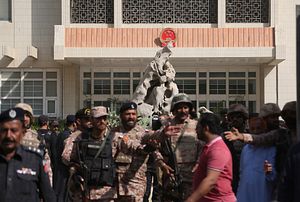On November 23, 2018, the Chinese consulate in Karachi came under attack by the Baloch Liberation Army (BLA). Soon after, the attack was framed within the narrative of the separatist insurgency in Balochistan and external players sabotaging the prospects of Chinese investment through the China-Pakistan Economic Corridor (CPEC). It is true that Baloch separatists, including the BLA, have long equated the Chinese investment in Balochistan as an exploitation of the mineral-rich province’s resources in collusion with Islamabad. Considering that Pakistan shares a troubled history in the region and China’s increasing prominence in the world through its economic investments has garnered Beijing a fair share of detractors, the argument of the attack slowing down the wheels of CPEC is tenable.
Yet, this narrative presents only part of the picture. A critical piece of the puzzle missing in current explanations is the centrality of Karachi as a site for subversive acts such as the attack on the Chinese consulate. Over the years, the city’s politics and governance have become complex and emergent. Political parties, until recently, resorted to violence against opponents; criminal actors were involved not only in criminal activities but also served as enforcers for political parties; and most players were involved in service provision rackets. Post-September 11, Karachi also became home to al-Qaeda fighters and chapters of Tehreek-e-Taliban Pakistan (TTP). Interventions by political loci of power in administrative and service provision institutions led corruption to unprecedented levels. This interplay of crime, politics, violent strategies, and governance-on-the-ground resulted in NATO weapons and related military gear being sold in Karachi. Weapons destined for international troops in Afghanistan became available in the city, accessible to crime groups as well as enforcers of political parties.
One could argue that the violence and use of weapons in Karachi’s politics that gained momentum in the 1980s and 1990s has only expanded and recently reached new heights with sophisticated automatic weapons and more impunity on the part of armed actors. This backdrop not only defines the history of the city but also provides an important lens to analyze current and future events.
Although the most recent military operation in the city seems to have brought some level of respite, the fundamentals of Karachi’s urban landscape have barely changed. After successive operations in the 1990s, Karachi’s armed actors primarily included the MQM, other political parties, and local jihadi groups. By the time the military operation was introduced in 2013, Karachi resembled a war zone (although the city had witnessed intense violence during the 1990s as well). In Karachi’s case, it wasn’t only that the number and types of armed actors increased over time. These players had also become involved in the city’s governance at one level or another. The TTP, for instance, was dispensing Sharia verdicts where it could. Groups related to it fought for control over the water supply as the money served as a revenue resource. The Peoples Aman Committee (PAC) representatives not only had access to the worlds of organized crime and politics; they represented emerging political players in their own right.
As scholarship from cities in Latin America, Africa, and the Middle East indicates, this dynamism is not unique to Karachi. Cities are living organisms — armed actors, governments, and political players are continually evolving. As more people move to cities over time, the politics and governance of a city respond and adapt as well. External stressors (for instance, war in a neighboring country) leave their mark as well as introduce new patterns in the city’s political economy and society. These processes take place within a city’s broader contexts (historical, political, geographical, social, cultural, and so on). Actors may and do learn from each other and past experiences. Thus, violence and crime may become as much a part of the system as part of the problem. It is within this complex landscape that the Chinese consulate survived the attack, albeit at the cost of seven Pakistani lives.
This complexity of Karachi is an important component in making sense of the recent attack. The city provides a warm ecosystem to armed players including crime groups and terrorists — Karachi’s mélange of armed players, including crime and terror groups and political players that have sizable constituencies of support, provide an environment where subversive players may find operational support and even willing partners. In the past, relationships between and among different players have not been uncommon — from links between criminal actors and the TTP to connections among local and transnational jihadi groups are known. The city’s centrality to the national economy also makes it an attractive target for conducting attacks that gain wider attention at the national and international level.
This importance of Karachi as a site for potential attacks as well as the complexity of its landscape needs to be taken in account when making sense of the recent attack on the Chinese consulate. The sheer expanse of the city along with its large population make it impossible to police every street. Punitive measures alone, as the city’s politics and governance suggest, fail to address this complexity. Nor can they contain emergent threats. The recent attack, although unique for putting the BLA’s asymmetric warfare on the urban map, was not the first one in Karachi, nor will it be the last.
Political solutions present a way forward. This means addressing the grievances of not only the Balochs but also the political stakeholders in Karachi for lasting peace. Last but not least, such solutions need to place the needs of the people in the heart of policymaking. Such an encompassing understanding and multifaceted policy responses are more suited to the breadth of the challenges faced in Karachi — the financial nerve center of Pakistan.
Dr. Nazia Hussain is a Project Assistant Professor based at the Policy Alternatives Research Institute (PARI) at the University of Tokyo. The views expressed here are her own.

































